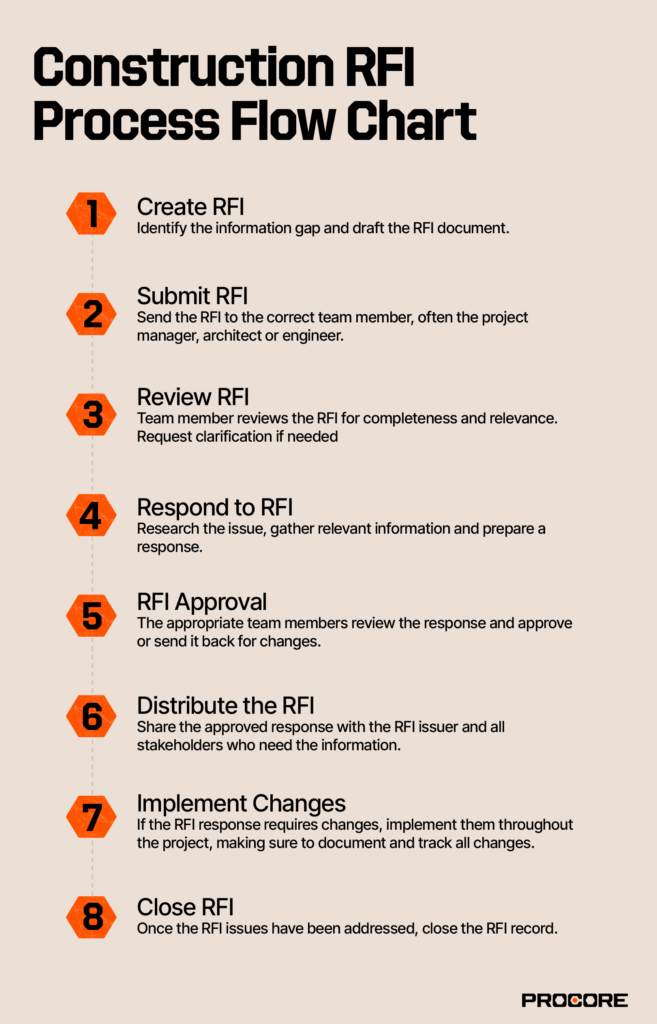Unravel the essential RFI meaning in construction and discover how this crucial communication tool can save your project from costly mistakes and delays.
Understanding RFIs in Modern Construction
In today’s complex construction landscape, effective communication is paramount to project success. Request for Information (RFI) documents have become increasingly critical, with studies showing that the average £5 million construction project generates over 100 RFIs. These formal queries serve as the backbone of project communication, ensuring clarity and precision in every aspect of construction. Recent data from the Construction Industry Institute reveals that poorly managed RFIs can increase project costs by up to 11% and cause significant schedule overruns. In the UK construction sector, where projects must adhere to strict Building Regulations and standards, RFIs play a vital role in maintaining compliance and quality control.
What is an RFI in Construction?
An RFI in construction is a formal written query submitted when project stakeholders need clarification on specifications, drawings, or other construction documents. It serves as a standardised communication tool between contractors, architects, engineers, and project owners. According to recent industry statistics, 22% of RFIs relate to design clarifications, while 18% address material specifications. The primary purposes of an RFI include:
- Seeking clarification on ambiguous design details
- Requesting additional information about specifications
- Proposing alternative solutions or materials
- Addressing discrepancies in construction documents
- Confirming interpretation of technical requirements
The Anatomy of an Effective Construction RFI
A well-structured RFI contains several essential components that ensure clear communication and prompt resolution. The document should be concise yet comprehensive, including:
- Project identification (name, number, location)
- RFI number and date
- Subject matter and reference documents
- Detailed description of the query
- Proposed solutions or alternatives
- Required response date
- Supporting documentation (photos, drawings, specifications)
When to Submit an RFI
Timing is crucial when submitting RFIs. In the UK construction industry, where projects face tight deadlines and regulatory requirements, knowing when to submit an RFI can prevent costly delays. Research indicates that 35% of construction delays are attributed to late or inadequate information exchange. Submit an RFI when:
1. Design documents contain conflicting information
2. Specifications require clarification
3. Site conditions differ from documented expectations
4. Alternative materials or methods need approval
5. Safety concerns arise requiring clarification
The RFI Process Flow
The RFI process follows a structured workflow that ensures efficient information exchange and documentation. A typical RFI lifecycle includes:
- Issue Identification: Contractor or team member spots a need for clarification
- RFI Creation: Formal document preparation with all relevant details
- Submission: Distribution to appropriate parties through prescribed channels
- Review: Recipients evaluate the query and gather necessary information
- Response: Detailed answer provided within the specified timeframe
- Documentation: Recording and archiving of the complete RFI exchange
RFI Best Practices and Common Pitfalls
To maximise the effectiveness of RFIs, construction professionals should follow established best practices while avoiding common mistakes. Studies show that well-managed RFIs can reduce project delays by up to 25%. Key recommendations include:
- Keep questions clear and specific
- Include relevant reference documents
- Propose potential solutions when possible
- Set realistic response deadlines
- Maintain professional tone and language
- Avoid multiple questions in a single RFI
Digital RFI Management and Modern Solutions
The construction industry is increasingly adopting digital solutions for RFI management. Modern construction management software platforms offer dedicated RFI modules that streamline the process. Recent surveys indicate that digital RFI management can reduce response times by up to 50%. These systems provide:
- Automated tracking and notifications
- Cloud-based document storage
- Real-time collaboration features
- Mobile accessibility for field personnel
- Integration with project management tools
Impact of RFIs on Project Timeline and Budget
The efficiency of RFI management directly affects project outcomes. Poor RFI handling can lead to significant delays and cost overruns. Recent UK construction industry data shows that projects with streamlined RFI processes experience 30% fewer delays and maintain better budget control. Effective RFI management helps:
- Reduce construction delays
- Minimise rework costs
- Improve resource allocation
- Enhance project coordination
- Maintain quality standards
Legal and Contractual Implications of RFIs
RFIs hold significant legal weight in construction contracts and dispute resolution. Under UK construction law, properly documented RFIs can protect parties from claims and provide evidence in contractual disputes. They serve as:
- Official project records
- Documentation of decision-making processes
- Evidence in dispute resolution
- Proof of due diligence
- Contract compliance documentation
Maximising RFI Efficiency in Your Construction Project
To optimise RFI management, implement these proven strategies:
- Establish clear RFI procedures at project start
- Use standardised templates and formats
- Set up efficient tracking systems
- Train team members on proper RFI usage
- Regular review and analysis of RFI patterns
- Implement continuous improvement measures
Conclusion: Mastering the RFI Process
Effective RFI management is crucial for successful construction project delivery in the UK market. By understanding the proper use, timing, and management of RFIs, construction professionals can significantly improve project outcomes. Remember that RFIs are not just administrative tasks but vital communication tools that can make or break a project’s success. Implement the strategies and best practices outlined above to ensure your RFI process supports rather than hinders your construction projects.
FAQ
What are common RFI mistakes?
RFI Writing Mistakes and How to Avoid Them. Common issues in RFI management include asking multiple questions in one RFI, providing too little context, and using unprofessional formatting. These are just a few.
Who typically issues RFIs?
A general contractor or subcontractor usually submits an RFI in written form to retrieve information from a design, engineering or construction professional. The information requested through an RFI is typically information that wasn’t included (or was unclear) in the scope of the construction contract.
Sources
[1] https://en.wikipedia.org/wiki/Electromagnetic_interference
[2] https://premiercs.com/blog/rfi-in-construction-find-out-how-the-process-works
[3] https://www.emc-directory.com/community/what-is-radio-frequency-interference-rfi


Leave a Reply